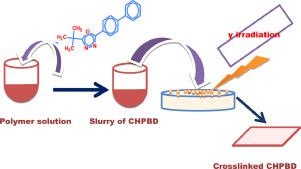Journal of Molecular Structure ( IF 4.0 ) Pub Date : 2021-05-20 , DOI: 10.1016/j.molstruc.2021.130699 Pushparekha , Balladka Kunhanna Sarojini , Shreedatta Hegde

|
Herein, versatile biopolymer chitosan films doped with 2-[(4-‑tert-butylphenyl)-5–(4-biphenyl)]-1, 3, 4- oxadiazole (PBD) a known OLED material were prepared by intercalation method. These films witnessed crosslinking which in turn exhibited exciting properties due to gamma irradiation with varied dosages. The radical mediated crosslinking of NH2 group with t‑butyl group was envisaged by the increased crystallinity of the films. The XPS analysis showed the formation of the bond between dopant and polymer backbone. The changes in binding energies of unirradiated and irradiated CHPBD films for N1s from 399.08 eV (1° amine) to 400.7 eV (2°amine), supported reaction of NH2 group with t‑butyl group of PBD in crosslinking of dopant and polymer matrix with the formation of C N linkage. In PXRD, peaks centered around 21.24° for pristine chitosan film, but for the unirradiated CHPBD, it was shifted to the lower angle16.09° to form amorphous film. However, for the irradiated CHPBD shifting to the higher angle 22.9°, 23.08°, 27.23° suggesting that dopant had chemically interacted with the polymer matrix. The Young's modulus, tensile strength indicated supportive properties. An interesting change in UV absorption behavior was observed for the unirradiated CHPBD exhibiting λmax at 290 nm with a hypsochromic shift with respected to dopant (λmax,309 nm). This indicated weak head-to-head alignment of dyes in an unirradiated matrix; whereas irradiation brought about changes through chemical crosslinking in the architecture of films with a redshift to 309 nm. Hyperchromism was also the effect of irradiation on films. The unirradiated films exhibited emission maxima around 369 nm whereas irradiated films showed 412 nm. Hence, a simple method was developed for the preparation of blue emissive biopolymeric materials.
N linkage. In PXRD, peaks centered around 21.24° for pristine chitosan film, but for the unirradiated CHPBD, it was shifted to the lower angle16.09° to form amorphous film. However, for the irradiated CHPBD shifting to the higher angle 22.9°, 23.08°, 27.23° suggesting that dopant had chemically interacted with the polymer matrix. The Young's modulus, tensile strength indicated supportive properties. An interesting change in UV absorption behavior was observed for the unirradiated CHPBD exhibiting λmax at 290 nm with a hypsochromic shift with respected to dopant (λmax,309 nm). This indicated weak head-to-head alignment of dyes in an unirradiated matrix; whereas irradiation brought about changes through chemical crosslinking in the architecture of films with a redshift to 309 nm. Hyperchromism was also the effect of irradiation on films. The unirradiated films exhibited emission maxima around 369 nm whereas irradiated films showed 412 nm. Hence, a simple method was developed for the preparation of blue emissive biopolymeric materials.
中文翻译:

用于光电应用的 2-[(4-叔丁基苯基)-5-(4-联苯)]-1, 3, 4-恶二唑 (PBD) 结合γ射线辐照壳聚糖薄膜的结构研究
在此,通过嵌入方法制备了掺杂 2-[(4-叔丁基苯基)-5-(4-联苯基)]-1, 3, 4-恶二唑 (PBD) 的多功能生物聚合物壳聚糖薄膜,该薄膜是一种已知的 OLED 材料。这些薄膜见证了交联,而交联又由于不同剂量的伽马辐射而表现出令人兴奋的特性。NH 2基团与叔丁基基团的自由基介导的交联是通过提高薄膜的结晶度来设想的。XPS 分析表明在掺杂剂和聚合物骨架之间形成了键。N1s 的未辐照和辐照 CHPBD 薄膜结合能从 399.08 eV(1°胺)到 400.7 eV(2°胺)的变化,支持 NH 2基团与 PBD 叔丁基在掺杂剂和聚合物基质交联中的反应随着 C 的形成 N 联动。在 PXRD 中,原始壳聚糖膜的峰集中在 21.24° 附近,但对于未辐照的 CHPBD,它移动到较低的角度 16.09° 以形成非晶膜。然而,对于辐照的 CHPBD 转移到更高的角度 22.9°、23.08°、27.23°,表明掺杂剂已与聚合物基质发生化学相互作用。杨氏模量、拉伸强度表明支持特性。对于未辐照的 CHPBD 观察到紫外吸收行为的一个有趣的变化,在 290 nm 处表现出 λ max,与掺杂剂有关的低色移(λ max,309 纳米)。这表明未辐照基质中染料的头对头排列较弱;而辐射通过化学交联导致薄膜结构发生变化,红移至 309 nm。超变色也是辐照对薄膜的影响。未经辐照的薄膜在 369 nm 附近表现出最大发射,而经辐照的薄膜则显示出 412 nm。因此,开发了一种简单的方法来制备蓝色发光生物聚合物材料。
N 联动。在 PXRD 中,原始壳聚糖膜的峰集中在 21.24° 附近,但对于未辐照的 CHPBD,它移动到较低的角度 16.09° 以形成非晶膜。然而,对于辐照的 CHPBD 转移到更高的角度 22.9°、23.08°、27.23°,表明掺杂剂已与聚合物基质发生化学相互作用。杨氏模量、拉伸强度表明支持特性。对于未辐照的 CHPBD 观察到紫外吸收行为的一个有趣的变化,在 290 nm 处表现出 λ max,与掺杂剂有关的低色移(λ max,309 纳米)。这表明未辐照基质中染料的头对头排列较弱;而辐射通过化学交联导致薄膜结构发生变化,红移至 309 nm。超变色也是辐照对薄膜的影响。未经辐照的薄膜在 369 nm 附近表现出最大发射,而经辐照的薄膜则显示出 412 nm。因此,开发了一种简单的方法来制备蓝色发光生物聚合物材料。


















































 京公网安备 11010802027423号
京公网安备 11010802027423号